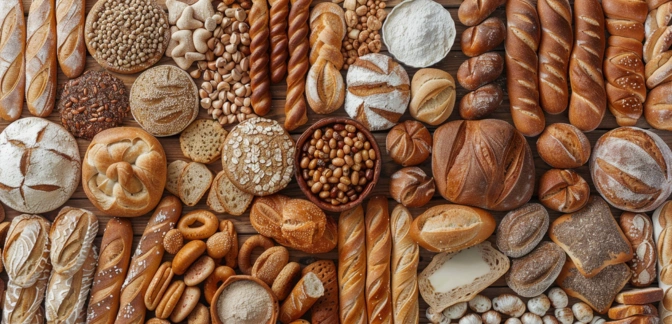Rye Bread — Nutrients, Health Benefits, And Shopping Tips

Written by Listonic Team
Last update on September 4, 2024
Rye bread nutrients
Nutrition facts
Amount per 100 g
Calories
🔥 250 kcal
| Nutrition per: 100 g | Value | % Daily Value* |
|---|---|---|
| Carbs | 48 g | 17.45% |
| Fiber | 6 g | 21.43% |
| Sugars | 5 g | 10% |
| Glycemic Index | 65 | - |
| Protein | 9 g | 18% |
| Sodium | 600 mg | 26.09% |
| Total Fat | 1 g | 1.28% |
*The % of Daily Value (DV) tells you how much a nutrient in a serving of food contributes to a daily diet. 2,000 calories a day is used for general nutrition advice.
6 g
🥔 Good Fiber Content
1 g
🥕 Low Fat Content
Rye bread facts & tips
Health benefits
- High in fiber, promoting digestive health, regular bowel movements, and maintaining a healthy gut microbiome.
- Rich in essential vitamins and minerals such as magnesium, phosphorus, and B vitamins, which support overall health and well-being.
- Provides sustained energy from complex carbohydrates, making it a good source of fuel for the body and brain.
- Supports heart health by helping to lower cholesterol levels and improve blood pressure.
Health risks
- High carbohydrate content which can cause rapid spikes in blood sugar levels, particularly concerning for diabetics when consumed in large quantities.
- Potential for gluten content making it unsuitable for individuals with celiac disease or gluten sensitivity, potentially causing digestive discomfort and other health issues.
- High sodium content in some commercial rye bread products, which can contribute to hypertension and increased cardiovascular risks.
- Potential for digestive discomfort such as bloating or gas when consumed in large quantities due to its high fiber content.
How to choose rye bread
Rye bread should feature a dense texture and a slightly sour aroma, characteristic of well-made rye. The crust should be thick and chewy, providing a robust bite.
Avoid rye bread that is overly dry or crumbly, as it may be stale. Bread with mold or a very strong odor should also be avoided, as it may indicate spoilage and is not safe to eat.

How to store rye bread
Rye bread should be stored at room temperature in an airtight container or bread box. Proper storage keeps it soft and fresh for up to a week.
Air exposure can cause rye bread to become stale. Avoid refrigerating the bread, as this can dry it out. Wrapping it tightly ensures the best texture and flavor. Consume within a few days of purchase for optimal freshness.
✅ Extra Tip
How long does it last?
Rye bread can last for 3-5 days at room temperature when stored in an airtight container. For longer storage, rye bread can be frozen for up to 3 months.
What to do with leftovers?
Leftover rye bread can be used in a variety of savory and hearty dishes. Toast it and serve with butter, jam, or cream cheese for a simple breakfast, or use it as a base for a sandwich or open-faced sandwich with meats, cheese, and vegetables. Rye bread is also great when turned into croutons by cubing, tossing with olive oil and seasonings, and baking until crispy.
Use rye bread to make a bread pudding by tearing it into pieces and mixing with eggs, milk, and spices, then baking until set. If you have a lot of rye bread, consider using it to make French toast by dipping it in an egg mixture and frying until golden. Rye bread can also be blended into breadcrumbs for coating meats or vegetables, or used as a base for stuffed mushrooms with cheese and herbs. For a quick snack, enjoy rye bread with smoked salmon, cream cheese, or a spread like hummus or guacamole.
👨⚕️️ Medical disclaimer
Discover products from other categories
Listonic Team
Fact-checked
Our editorial team checked this article to make sure it was accurate at the time of publishing it.
Get the top-rated shopping list app

rye bread
1 piece
Outline







